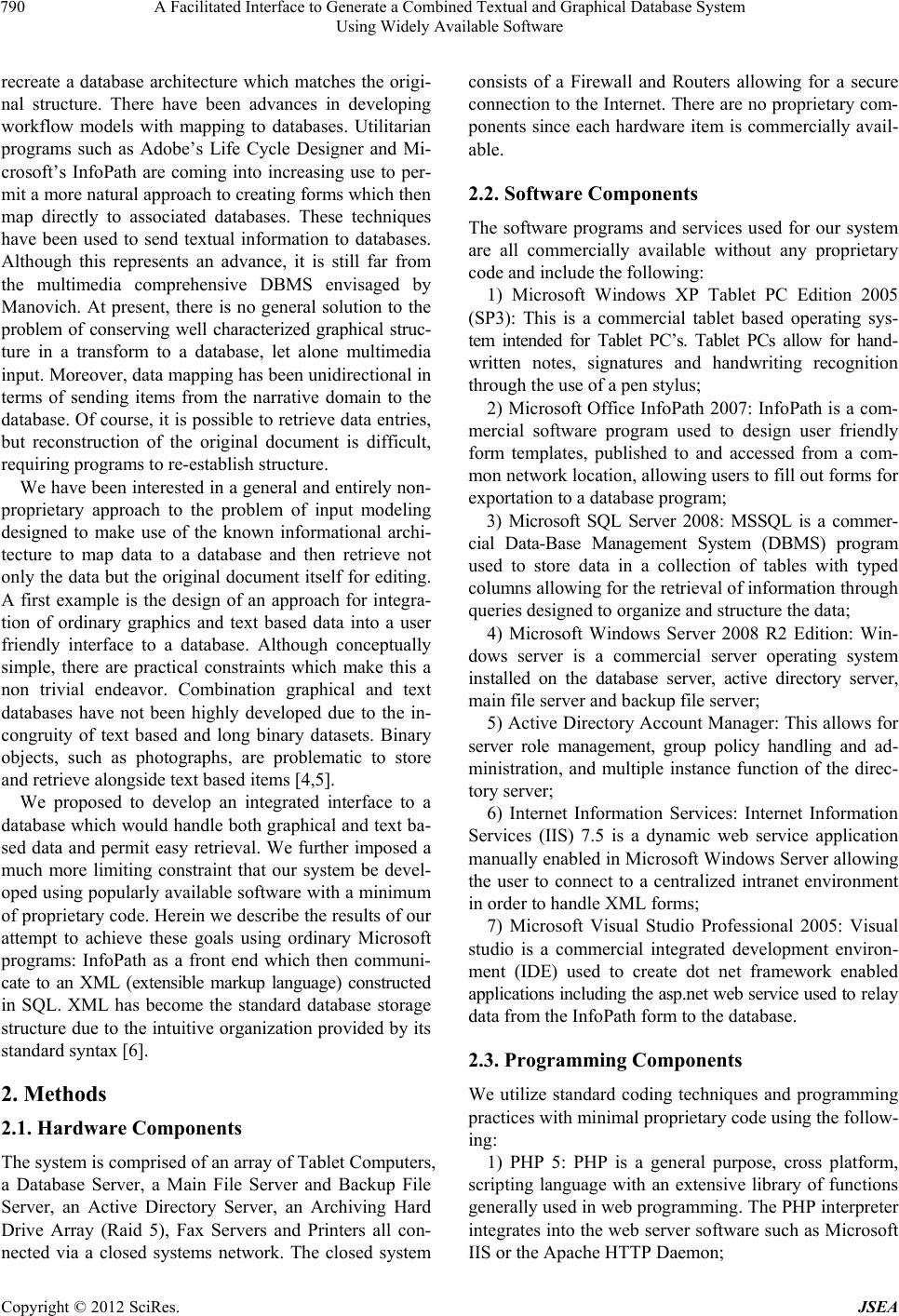
A Facilitated Interface to Generate a Combined Textual and Graphical Database System
Using Widely Available Software
790
recreate a database architecture which matches the origi-
nal structure. There have been advances in developing
workflow models with mapping to databases. Utilitarian
programs such as Adobe’s Life Cycle Designer and Mi-
crosoft’s InfoPath are coming into increasing use to per-
mit a more natural approach to creating forms which then
map directly to associated databases. These techniques
have been used to send textual information to databases.
Although this represents an advance, it is still far from
the multimedia comprehensive DBMS envisaged by
Manovich. At present, there is no general solution to the
problem of conserving well characterized graphical struc-
ture in a transform to a database, let alone multimedia
input. Moreover, data mapping has been unidirectional in
terms of sending items from the narrative domain to the
database. Of course, it is possible to retrieve data entries,
but reconstruction of the original document is difficult,
requiring programs to re-establish structure.
We have been interested in a general and entirely non-
proprietary approach to the problem of input modeling
designed to make use of the known informational archi-
tecture to map data to a database and then retrieve not
only the data but the original document itself for editing.
A first example is the design of an approach for integra-
tion of ordinary graphics and text based data into a user
friendly interface to a database. Although conceptually
simple, there are practical constraints which make this a
non trivial endeavor. Combination graphical and text
databases have not been highly developed due to the in-
congruity of text based and long binary datasets. Binary
objects, such as photographs, are problematic to store
and retrieve alongside text based items [4,5].
We proposed to develop an integrated interface to a
database which would handle both graphical and text ba-
sed data and permit easy retrieval. We further imposed a
much more limiting constraint that our system be devel-
oped using popularly available software with a minimum
of proprietary code. Herein we describe the results of our
attempt to achieve these goals using ordinary Microsoft
programs: InfoPath as a front end which then communi-
cate to an XML (extensible markup language) constructed
in SQL. XML has become the standard database storage
structure due to the intuitive organization provided by its
standard syntax [6].
2. Methods
2.1. Hardware Components
The system is comprised of an array of Tablet Computers,
a Database Server, a Main File Server and Backup File
Server, an Active Directory Server, an Archiving Hard
Drive Array (Raid 5), Fax Servers and Printers all con-
nected via a closed systems network. The closed system
consists of a Firewall and Routers allowing for a secure
connection to the Internet. There are no proprietary com-
ponents since each hardware item is commercially avail-
able.
2.2. Software Components
The software programs and services used for our system
are all commercially available without any proprietary
code and include the following:
1) Microsoft Windows XP Tablet PC Edition 2005
(SP3): This is a commercial tablet based operating sys-
tem intended for Tablet PC’s. Tablet PCs allow for hand-
written notes, signatures and handwriting recognition
through the use of a pen stylus;
2) Microsoft Office InfoPath 2007: InfoPath is a com-
mercial software program used to design user friendly
form templates, published to and accessed from a com-
mon network location, allowing users to fill out forms for
exportation to a database program;
3) Microsoft SQL Server 2008: MSSQL is a commer-
cial Data-Base Management System (DBMS) program
used to store data in a collection of tables with typed
columns allowing for the retrieval of information through
queries designed to organize and structure the data;
4) Microsoft Windows Server 2008 R2 Edition: Win-
dows server is a commercial server operating system
installed on the database server, active directory server,
main file server and backup file server;
5) Active Directory Account Manager: This allows for
server role management, group policy handling and ad-
ministration, and multiple instance function of the direc-
tory server;
6) Internet Information Services: Internet Information
Services (IIS) 7.5 is a dynamic web service application
manually enabled in Microsoft Windows Server allowing
the user to connect to a centralized intranet environment
in order to handle XML forms;
7) Microsoft Visual Studio Professional 2005: Visual
studio is a commercial integrated development environ-
ment (IDE) used to create dot net framework enabled
applications including the asp.net web service used to relay
data from the InfoPath form to the database.
2.3. Programming Components
We utilize standard coding techniques and programming
practices with minimal proprietary code using the follow-
ing:
1) PHP 5: PHP is a general purpose, cross platform,
scripting language with an extensive library of functions
generally used in web programming. The PHP interpreter
integrates into the web server software such as Microsoft
IIS or the Apache HTTP Daemon;
Copyright © 2012 SciRes. JSEA